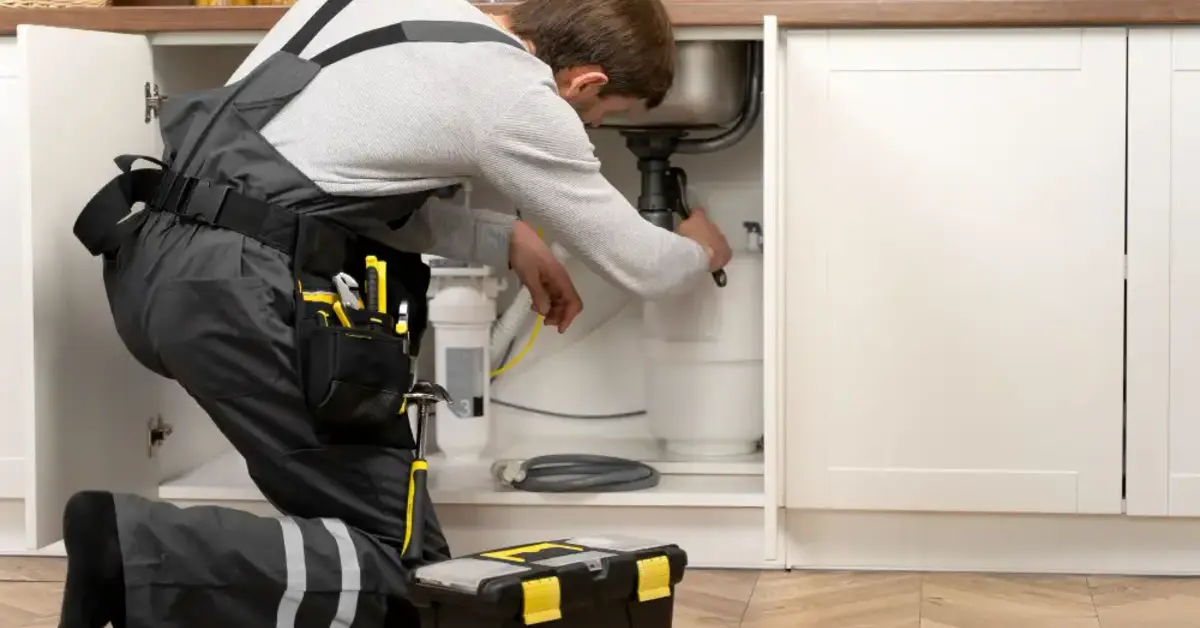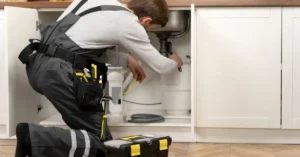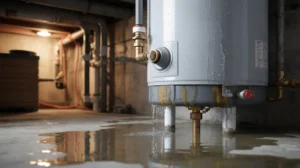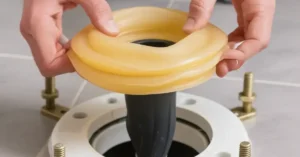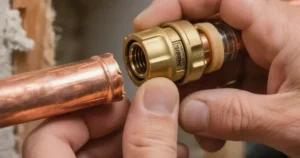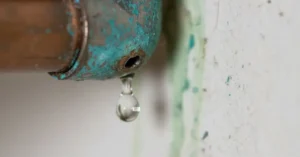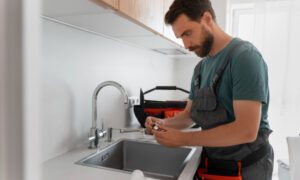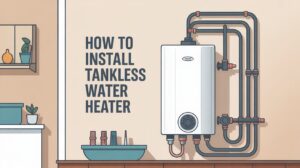A loud grinding noise from your kitchen sink disposal is never good, but a gentle humming can be just as frustrating when the unit refuses to work. The good news is that this common issue usually has a simple fix you can do yourself. This article will show you how to repair garbage disposal humming using easy and professional steps.
The humming sound means the motor is getting power but the shredder plate the part that grinds food is stuck, preventing it from spinning. The most common cause is a jam from a piece of food waste or a foreign object.
What Does It Mean When Your Garbage Disposal Is Humming?
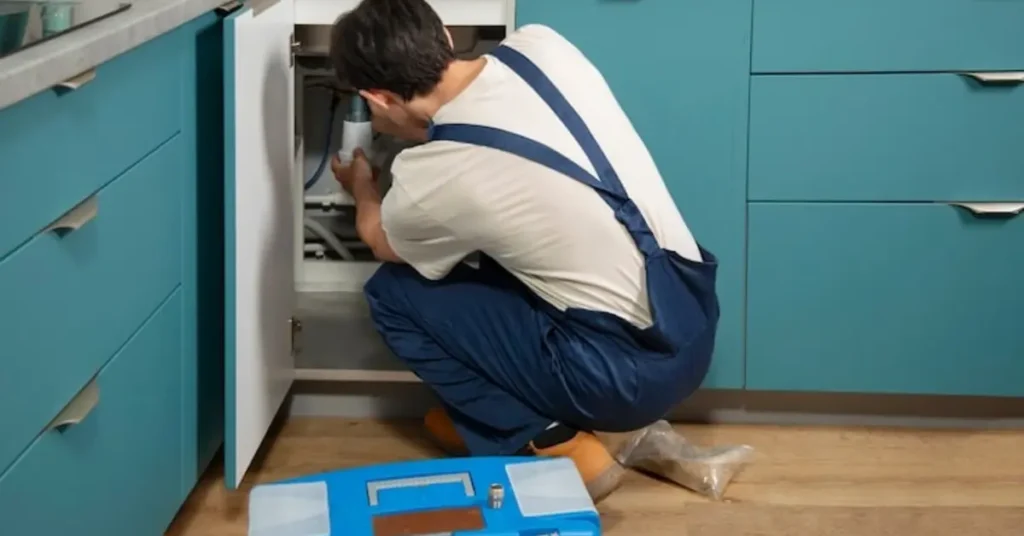
A humming garbage disposal means the motor is getting power but the blades can’t spin. The motor tries to turn but something blocks the grinding plate. This creates that distinctive humming or buzzing noise you hear.The sound tells you the electrical parts work fine. The problem sits in the grinding chamber where food gets stuck. The motor hums because it’s working against resistance it can’t overcome.
If you ignore a humming disposal, the motor can overheat and burn out. This turns a simple fix into an expensive replacement. Acting quickly protects your investment and prevents water damage from a backed-up sink.
Common Causes of a Humming Garbage Disposal
Foreign Objects Jamming the Blades
Small items fall into your disposal without you noticing. Bottle caps, twist ties, broken glass, or utensils wedge between the blades and housing. These objects stop the impeller plate from rotating even though the motor runs.Metal objects cause the most damage because they’re hard and don’t break down. Even a small piece of broken dishware can lock up the entire system.
Accumulated Food Buildup
Fibrous foods like celery, potato peels, and corn husks wrap around the blades. Starchy foods like pasta and rice expand and create thick paste. Grease hardens and glues everything together.This buildup happens slowly over weeks or months. One day you add just enough food to tip the scale from working to jammed. The disposal can’t push through the mass of stuck material.
Tripped Reset Button
Your disposal has a built-in safety feature on the bottom. When the motor works too hard or overheats, a red reset button pops out. This cuts power to protect the motor from damage.A tripped reset button makes your garburator humming but not working. The motor tries to start but the safety switch keeps it from running at full power.
Worn Internal Components
Garbage disposals last 8 to 15 years with proper care. The bearings wear down over time. The flywheel loosens. The mounting assembly corrodes from constant water exposure.Old disposals develop more friction in their moving parts. This makes them more likely to jam and harder to free when they do. A disposal near the end of its life jams more often.
Step-by-Step Guide: How to Repair Garbage Disposal Humming
Safety First: Turn Off the Power
Find your circuit breaker box and flip the switch for your garbage disposal. Never work on a disposal with the power on. Unplug the unit if it has a power cord under the sink.Test that the power is off by flipping the wall switch. You should hear nothing. This simple step prevents serious injury from accidental startup.
Check and Press the Reset Button
Look under your sink at the bottom of the disposal. Find the small red or black button that sticks out. Push it firmly until you hear or feel it click back in.Wait five minutes for the motor to cool if the button won’t stay in. Try pressing it again. If it keeps popping out, you have a bigger problem that needs professional help.
Use the Allen Wrench Method
Most disposals come with a small Allen wrench (hex key). Look for a hexagonal hole in the center bottom of your unit. Insert the wrench and turn it back and forth.This manual rotation breaks up jams and frees stuck blades. Turn the wrench clockwise and counterclockwise several times. You’ll feel resistance at first, then it should move more freely.If you lost the original wrench, a 1/4-inch Allen wrench from any hardware store works. Keep one under your sink for future use.
Remove the Jam from Above
Turn on a flashlight and look into the drain opening. Never put your hand inside. Use long pliers or tongs to grab visible objects.Remove any foreign items you see. Pull out fibrous food waste that’s wrapped around the visible parts. Work slowly and carefully to avoid pushing items deeper.
Use a Wooden Spoon Handle
If you don’t have the Allen wrench, use a wooden spoon or broom handle. Insert it into the disposal and push against one of the blades. Apply firm pressure to rotate the flywheel manually.Work the handle back and forth to free the jam. This method takes more effort but works when you need a quick fix. The wood won’t damage the disposal like metal tools might.
Clear the Drain Line
Sometimes the issue is farther down in the drainpipe. Your sink disposal not working might be a clog below the unit. Check the P-trap under the sink for blockages.Place a bucket under the trap and unscrew the fittings. Remove built-up material and flush the pipe with water. Reassemble everything tightly to prevent leaks.
Test Your Disposal
Turn the power back on at the circuit breaker. Run cold water into the sink. Flip the disposal switch and listen for normal grinding sounds.Feed small amounts of soft food waste to test it. If your garbage disposal just hums again, turn it off immediately. You may need to repeat the repair steps or call for help.
Preventing Future Garbage Disposal Humming
Run Cold Water Always
Start the water before you turn on the disposal. Keep it running for 30 seconds after you turn the disposal off. Cold water solidifies grease so it grinds up instead of coating the pipes.Hot water melts grease, which then sticks to your pipes and disposal parts. This creates the buildup that leads to jams. Cold water is your best defense against future problems.
Avoid Problem Foods
Keep these items out of your disposal: bones, fruit pits, coffee grounds, eggshells, pasta, rice, potato peels, celery, onion skins, and grease. These foods either don’t grind well or expand in water.Coffee grounds seem small but they clump together like wet sand. Eggshells create tiny granules that stick to grease. Pasta and rice swell up and form paste.
Feed Food Gradually
Don’t overload your disposal with large amounts at once. Add food in small batches with plenty of water. Let each batch grind completely before adding more.Pushing too much food at once overwhelms the blades. The disposal bogs down and can’t clear the grinding chamber. This causes jams and makes the motor work harder than necessary.
Regular Cleaning Maintenance
Clean your disposal weekly with ice cubes and rock salt. The ice sharpens the blades while the salt scrubs away buildup. Run the disposal with cold water for 30 seconds.Once a month, grind citrus peels to freshen the smell and help break down grease. The citric acid cuts through residue naturally. These simple habits extend your disposal’s life.
Listen for Warning Signs
A disposal that slows down or sounds different is telling you something. Grinding that takes longer than normal means buildup is starting. Strange rattling suggests a loose object inside.Address these early warnings before your garbage disposal not turning becomes a full jam. Small preventive actions save you from bigger repairs later.
When to Call a Professional Plumber
The Reset Button Keeps Tripping
If the reset button pops out repeatedly after you fix the jam, the motor has internal damage. The thermal overload protection is activating because something inside is wrong.This usually means worn bearings or a failing motor. Continuing to reset and run the disposal will burn it out completely. A plumber can diagnose whether repair or replacement makes more sense.
Water Leaks from the Unit
Leaks from the disposal body or mounting assembly indicate seal failure or cracks. These parts are under pressure and leaks get worse over time. Water damage to your cabinet can cost more than fixing the disposal.A professional can determine if new seals will fix it or if the housing is cracked. Cracked housings require full replacement since they can’t be reliably repaired.
Strange Electrical Issues
If your circuit breaker trips when you run the disposal, you have an electrical problem. Sparks, burning smells, or a disposal that won’t turn on at all need professional attention.Electrical issues can be dangerous and may indicate problems with your home’s wiring. Don’t attempt repairs yourself. A licensed plumber or electrician should handle these situations.
The Disposal is Very Old
A disposal over 12 years old that jams frequently is telling you it’s time to retire. Repeated repairs add up quickly. New models are more efficient and powerful.Modern disposals have better motors and longer warranties. They handle food waste more effectively and last longer. Sometimes replacement is the smarter financial choice.
You Can’t Free the Jam
If you’ve tried all the repair steps and your my garbage disposal just hums, something is seriously stuck. A professional has specialized tools to disassemble the unit safely.Forcing a stuck disposal can damage the motor or housing. A plumber can determine if the jam is removable or if the internal parts are damaged beyond simple repair.
You can read about: How to Replace a Garbage Disposal?
Garbage Disposal Repair and Installation in Los Angeles
Los Angeles homeowners face unique challenges with older plumbing systems and hard water. If you need expert help with your disposal issues, professional service makes the difference between a quick fix and ongoing problems.Derks Plumbing offers reliable Garbage Disposal Repair Eagle Rock and throughout the Los Angeles area. Our experienced technicians handle everything from simple jams to complete installations. We arrive with the right tools and parts to fix your problem in one visit.We understand that a broken disposal disrupts your whole kitchen. Our team provides same-day service for emergency repairs.
We also offer honest advice about whether repair or replacement serves you better.Our installation service includes proper mounting, electrical connections, and testing. We make sure your new disposal works perfectly and explain how to maintain it. All our work comes with a satisfaction guarantee.
Conclusion
A humming garbage disposal is frustrating but usually fixable in minutes. Most problems come from jammed blades caused by foreign objects or food buildup. The reset button, Allen wrench method, and manual clearing solve most issues.Prevention is easier than repair. Run cold water, avoid problem foods, and maintain your disposal regularly. These habits keep your disposal working smoothly for years.Know when to call for help. Persistent problems, leaks, and electrical issues need professional attention.
Don’t risk injury or expensive damage trying to fix serious problems yourself.Understanding how to repair garbage disposal humming saves you money and keeps your kitchen running. Most fixes take less time than ordering takeout because your sink is backed up.
FAQs
How long should a garbage disposal last?
A quality garbage disposal lasts 8 to 15 years with proper maintenance. Cheap models may fail in 5 years while premium units can reach 20 years. Regular cleaning and careful use extend the lifespan.
Can I use Drano in a garbage disposal?
Never use Drano or chemical drain cleaners in a disposal. These products damage the rubber and plastic parts. They also don’t dissolve the types of clogs that happen in disposals. Use mechanical methods instead.
Why does my disposal hum but not spin?
The motor runs but something blocks the flywheel from rotating. This is usually a jammed object or thick food buildup. The motor can’t overcome the resistance so it just hums while trying.
Is it safe to put my hand in the garbage disposal?
Never put your hand inside a garbage disposal, even with the power off. Use pliers, tongs, or wooden tools to remove objects. The blades are sharp and an accidental startup can cause severe injury.
How much does it cost to fix a humming disposal?
DIY repairs cost nothing if you have basic tools. Professional service runs $100 to $200 for simple jams. Replacement units cost $150 to $500 installed, depending on the model and your location.

